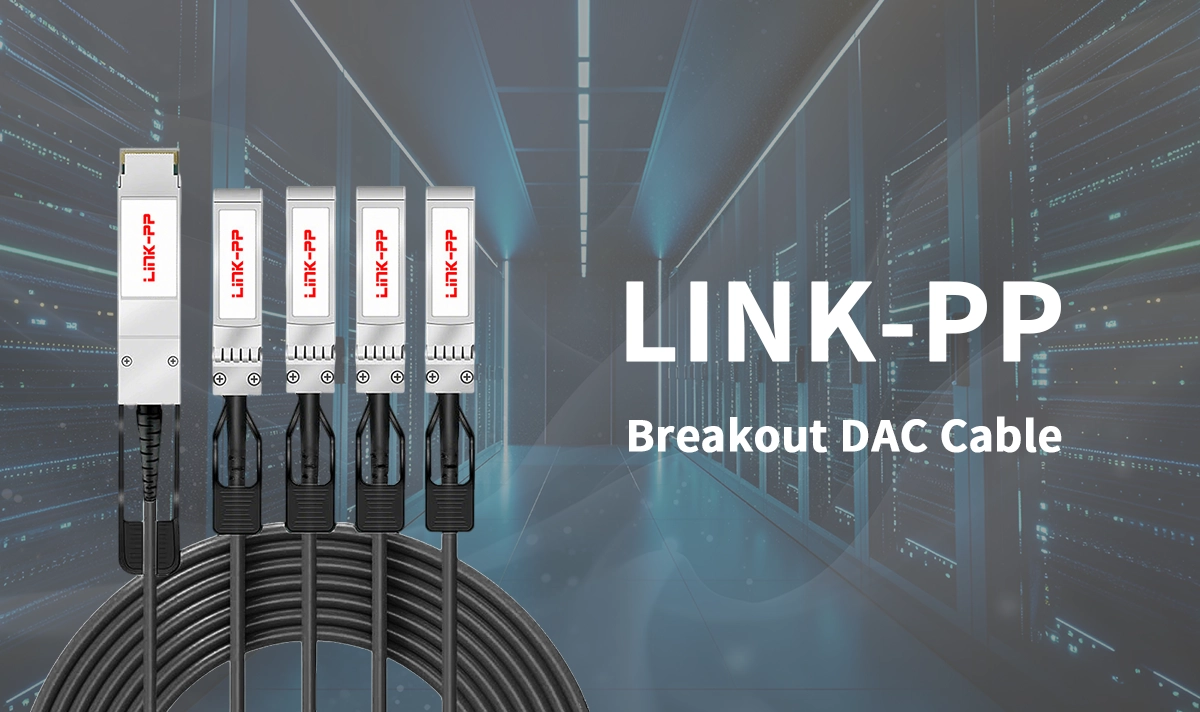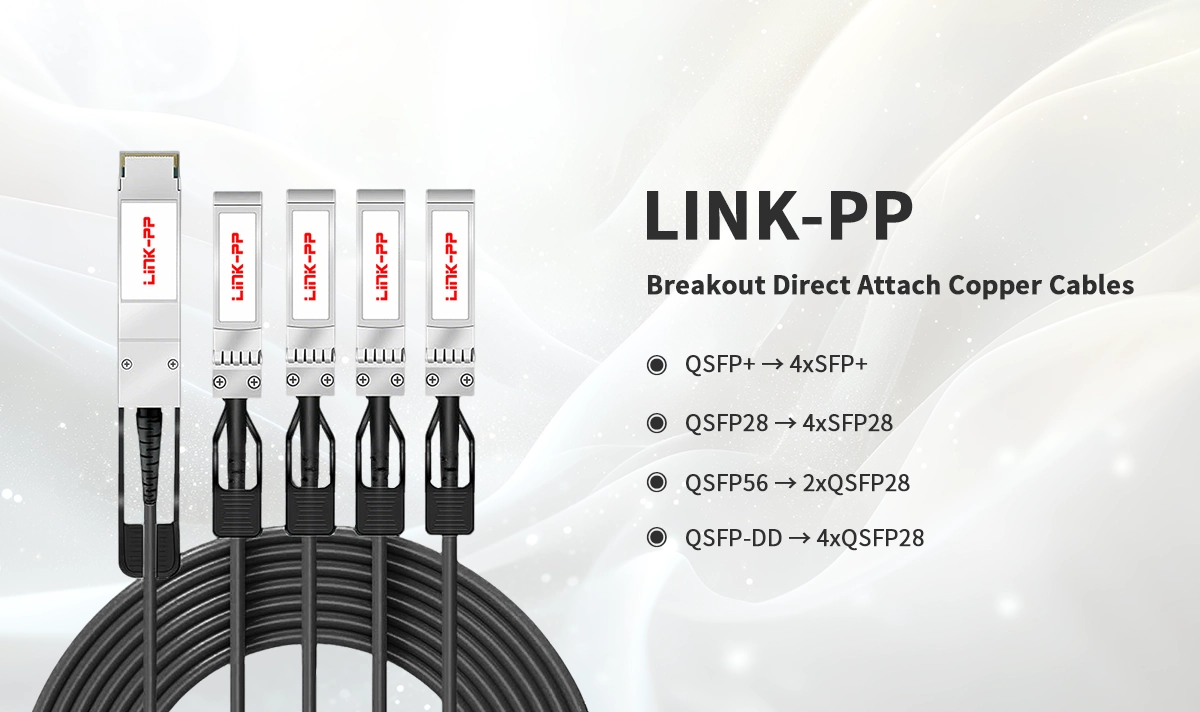
In the high-speed world of data centers and enterprise networking, efficiently managing bandwidth and physical space is non-negotiable. While standard Direct Attach Copper Cables (DACs) are staples for point-to-point connections, a specialized variant plays a crucial role in optimizing high-density environments: the Breakout DAC Cable. If you've ever wondered "what is breakout DAC cable" and how it differs from its standard counterpart, you're in the right place. This guide demystifies breakout DACs, explores their advantages, key use cases, and introduces reliable LINK-PP solutions to power your infrastructure.
➣ What Exactly is a Breakout DAC Cable?
At its core, a breakout DAC cable (sometimes called a fanout cable) is a single, passive copper cable assembly designed to connect one high-density port (like QSFP28, QSFP+, or OSFP) on a switch or router to multiple lower-speed ports (like SFP28, SFP+, or SFP) on another device, typically a server or storage unit. Unlike a standard DAC connecting one port to one port (e.g., QSFP28 to QSFP28), a breakout DAC literally "breaks out" the lanes or channels from the high-density module into separate, individual lower-speed connections.
🔍 Key Components & How It Works:
High-Density Connector (One End): Terminates in a single connector like QSFP+ (4x 10G lanes), QSFP28 (4x 25G or 1x 100G lanes), or OSFP/QSFP-DD for higher densities.
Multiple Lower-Density Connectors (Other End): Splits into typically 2, 4, or sometimes 8 separate cables, each ending in connectors like SFP+ (10G), SFP28 (25G), or SFP (1G).
Integrated Copper Wires: Passively transmits electrical signals between the ports without needing signal conversion (like active cables or optical modules). Passive DACs are cost-effective and low-power.
Channel Separation: The fundamental principle involves utilizing the independent transmit (Tx) and receive (Rx) lanes within the high-density connector and routing each lane pair to a separate lower-speed port. For example, a single QSFP+ port (with 4 independent 10G channels) connects via a breakout DAC to four separate SFP+ ports (each handling one 10G channel).
➣ Breakout DAC vs. Standard DAC: Clearing the Confusion
Let's clarify the primary differences:
Feature | Standard DAC Cable | Breakout DAC Cable |
|---|---|---|
Connection Type | Point-to-Point (1:1) | High-Density to Multiple Ports (1:4, 1:2, etc.) |
Typical Use Case | Connecting switches directly, switch to server (single link) | Connecting core switch to multiple TOR switches or servers, optimizing high-density ports |
Port Utilization | Uses one port per connection | Maximizes one high-density port for multiple connections |
Cable Ends | 2 Identical Connectors (e.g., QSFP28 to QSFP28) | 1 High-Density Connector (e.g., QSFP+) + Multiple Lower-Density Connectors (e.g., 4x SFP+) |
Cost Per Port | Higher (uses dedicated ports) | Lower (shares cost of high-density port) |
Complexity | Simpler | Requires correct port configuration (breakout mode) on the switch |
Example | QSFP28 DAC (100G to 100G) | QSFP+ to 4x SFP+ DAC (40G split to 4x 10G) |
➣ Why Use a Breakout DAC Cable? Key Advantages
Significant Cost Savings: This is often the biggest driver. Breakout DACs leverage the typically lower cost per port of high-density switch ports. Instead of buying four individual 10G SFP+ ports and cables, you use one QSFP+ port and a breakout cable, drastically reducing the total cost of ownership (TCO) for connectivity, especially compared to multiple optical transceivers and fiber. Passive DAC cables are inherently cheaper than active or optical solutions.
Maximized Port Density & Efficiency: Breakout cables unlock the true potential of high-density switches. A single QSFP28 port (100G) can provide four independent 25G server connections using a breakout DAC, vastly improving rack space utilization and simplifying cable management compared to running four separate cables from four individual ports. This is crucial for top-of-rack (TOR) switching and leaf-spine architectures.
Reduced Power Consumption: Like all passive DACs, breakout variants consume minimal power (often < 0.1W per end) compared to active copper cables (AECs) or optical transceivers (which can consume 1W or more per module). This contributes to lower operating costs and cooler running temperatures in dense environments.
Lower Latency: Passive electrical connections offer the lowest possible latency for short-reach applications within racks or between adjacent racks.
Simplified Cabling (vs. Multiple Singles): While managing the multiple legs of a breakout cable requires care, it's often simpler than managing four completely separate DACs running from the same switch port group. It reduces cable clutter at the switch end.
Common Applications & Use Cases
Breakout DACs shine in specific scenarios:
Connecting Core/Aggregation Switches to TOR Switches: A high-density QSFP28 port on a core switch can use a breakout DAC (e.g., QSFP28 to 4x SFP28) to connect to four separate TOR switches, each receiving a 25G uplink. This efficiently utilizes core switch ports.
High-Density Server Connectivity (TOR to Servers): A TOR switch with QSFP+ ports can use QSFP+ to 4x SFP+ breakout DACs to connect to four servers, each getting a dedicated 10G link, maximizing the value of the TOR switch ports. Ideal for server racks needing multiple 10G or 25G connections.
Storage Array Connections: Connecting high-bandwidth storage arrays (equipped with high-density ports) to multiple hosts or switches.
Migration Paths: Gradually upgrading from 10G (SFP+) server connections to 25G/100G without immediately replacing all server NICs. Use breakout DACs from new 100G (QSFP28) switches to existing 10G servers until upgrades are complete.
⚠️ Critical Consideration: Breakout Mode
The switch port connected to the high-density end of the breakout DAC MUST be explicitly configured for breakout mode (sometimes called port splitting or channelization). This tells the switch to treat its single physical port as multiple logical ports (e.g., configuring a 40G QSFP+ port as 4x 10G). Not all switches or all ports support breakout. Always consult your switch documentation before deploying breakout DACs.
➣ LINK-PP: Your Partner for Reliable Breakout DAC Solutions

When performance, reliability, and cost-efficiency matter for your high-density connections, LINK-PP breakout DAC cables deliver. Engineered to meet rigorous standards, our cables ensure optimal signal integrity for critical data center and enterprise applications.
Popular LINK-PP Breakout DAC Cable Examples:
LINK-PP LQ-DAC1440-1MN: The workhorse for 40G to 10G breakout. Connects one QSFP+ (40G) port to four SFP+ (10G) ports. Ideal for TOR to server connectivity. Available in various lengths (1m, 3m, 5m).
LINK-PP LQ-DAC14100-2MN: Designed for modern 100G to 25G migration. Connects one QSFP28 (100G) port to four SFP28 (25G) ports. Perfect for high-performance computing and next-gen server racks.
LINK-PP DAC cables are rigorously tested for compatibility with major switch vendors (Cisco, Arista, Juniper, Mellanox/NVIDIA, HPE, Dell, etc.) and offer a cost-effective, low-power, low-latency alternative to optical solutions for short reaches.
➣ Conclusion: Optimize Your Density with Breakout DACs
Breakout DAC cables are powerful tools in the network architect's arsenal. By understanding what a breakout DAC cable is and its core advantages – significant cost savings, maximized port density, lower power consumption, and minimal latency – you can make informed decisions to optimize your high-density environments like data centers and enterprise networks. They provide an elegant, economical solution for connecting high-speed core/aggregation switches to multiple TOR switches or servers.
Ready to simplify your high-density cabling and reduce costs?
👉 Explore LINK-PP's range of high-performance, reliable Breakout DAC Cables today! Find the perfect solution for your 40G to 10G, 100G to 25G, or other breakout needs.
For a personalized recommendation, contact our experts ➞
➣ FAQ
What devices work with breakout DAC cables?
Most breakout DAC cables connect to switches, routers, and servers. These devices must have QSFP or SFP ports. Many major brands support these cables, making them a common choice in data centers and labs.
What is the maximum distance for breakout DAC cables?
Breakout DAC cables usually work best up to 7 meters. The copper wires inside limit the distance. For longer connections, engineers often use fiber optic cables.
What makes breakout DAC different from standard DAC?
Breakout DAC splits one high-speed port into several lower-speed ports. Standard DAC connects two ports with the same speed. Breakout DAC helps teams link more devices using one main port.
What are the main benefits of using breakout DAC?
Breakout DAC cables cost less than fiber optic cables. They move data quickly and do not need extra power. Teams use them for short, strong links in racks or rooms.
What problems can happen with breakout DAC cables?
Breakout DAC cables can be thick and heavy. They may pick up interference from other electronics. The short distance limit means teams cannot use them for far connections.
➣ See Also
What is an Active Optical Cable and How Does It Work
What You Need to Know About Direct Attach Cables (DAC)




